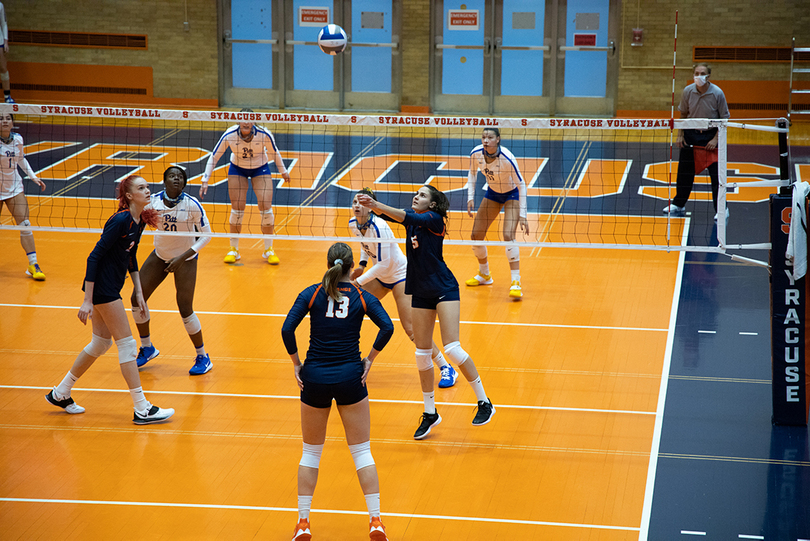European volleyball players adjust to life in Syracuse, new style of play

Sarah Lee | Asst. Photo Editor
Syracuse has more European-born volleyball players than any other ACC program and is home to 40% of European volleyball players in the conference.
The Daily Orange is a nonprofit newsroom that receives no funding from Syracuse University. Consider donating today to support our mission.
Elena Karakasi and Abby Casiano spent the entire summer together. With Karakasi unable to return home to Athens, Greece, due to COVID-19 travel restrictions, Casiano welcomed Karakasi into her home in Riverview, Florida.
With nearly half of its players from Europe, Syracuse has more European-born volleyball athletes than any other Atlantic Coast Conference program and is home to 40% of European volleyball players in the conference. For Karakasi and her five European-born teammates, playing NCAA volleyball forced them to adapt to a style of play different from what they had experienced before.
“It’s just (a) different energy, different vibe, different warmup,” Marina Markova, from St. Petersburg, Russia, said.
Many minor rules differ between Europe and the U.S., Markova said, including what happens when the ball hits the ceiling and the fact that setter assists are not an official statistic. In the U.S., the team captain’s role is an honorary position, with responsibilities varying from team to team, but in Europe, however, the captain is second in command behind the head coach.
According to SU head coach Leonid Yelin, who’s had significant coaching stints in both Europe and the U.S., volleyball is structured differently on the two continents. In the U.S., the best high school athletes in the country usually play in college. In Europe, the European Volleyball Confederation has competitive club teams that the best players join. Yelin described college teams in Europe as “intramural” level teams.
“As much as it looks we have a lot of international players, it’s still few — how many good, young players playing in different countries come to us,” Yelin said.
Yelin, who is from Uzbekistan, said he frequently uses connections he has overseas to bring international players to SU. Sophomore Viktoriia Lokhmanchuk and senior Yuliia Yastrub are two of the only Division I volleyball players from Ukraine, a country where Yelin spent several years coaching. He also said that he had connections in Russia that helped him recruit Markova and two-time All-ACC first team selection Polina Shemanova. Yelin traveled to Russia to recruit both of them in person.
We’re not dividing them by where they’re from. If I could get (a) player from the moon, if she is a good player, good person, good student, I would take her.Leonid Yelin, Syracuse volleyball coach
Since he started coaching Division I volleyball in 2004, Yelin has never coached a team without at least one European player. And since coming to Syracuse in 2011, he has never had fewer than three. Despite the large number of international players, Yelin said he does not put any special emphasis on recruiting in Europe — rather, he tries to seek out the best talent he can.
“We’re not dividing them by where they’re from,” Yelin said. “If I could get (a) player from the moon, if she is a good player, good person, good student, I would take her.”
Regardless, Yelin’s European recruiting has paid off. Last season, Shemanova broke her own program record for kills in a season with the current scoring format. Karakasi is 10th in school history for career assists. Markova was second on the team with 22 aces as a freshman. This season, two of the team’s three captains are European.
For Karakasi, the diversity of the team is what brings them together. Players from different countries and states have playing styles that make the team unique. How she played in Greece might be different from how Markova played in Russia or how Casiano played in the U.S. What’s important to her, she said, is that they are all able to come together and mesh as a team.
“I don’t really think it’s Europe vs America,” Karakasi said. “It’s (more) like Syracuse.”
Asst. Sports Editor Alex Hamer contributed reporting to this article.





